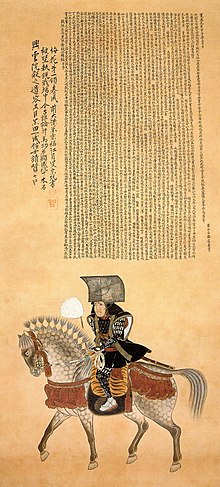Kabuto
As Kabuto ( jap. 兜 ) is defined as the helmets by the state of the Japanese warrior samurai to their armor ( Yoroi be worn). There are different types of Kabuto , which are named depending on the materials used or the type of construction. Generally speaking, kabuto are the large, ornate helmets that can be seen in films and photographs in the media and literature.
description
In the area of the forehead, the helmet has a particularly reinforced middle section to protect the men’s area (forehead and crown region, one of the traditional targets of classical Japanese weaponry), plates or chain armor at the back and sides protect the neck and neck and ornaments and helmet decorations ( Maedate ) indicate the clan of the wearer. For the face part, depending on the type of helmet, the mempō mask was often added, which was intended to protect the face in part, but also to intimidate the opponent.
The kabuto was often made with a leather cap that was covered with different layers of metal. Other versions consisted of chain or plate armor , sometimes a mixture of the two, attached to a fabric hood for better cushioning . On the battlefield, they not only served to protect the wearer, but also had a representative character, indicating the power and status of the wearer. For this reason, especially during the Heian and Kamakura periods, many different types of lavishly decorated, splendid copies of the Kabuto were made.
The heavy weight of a Kabuto led to the emergence of some hand-to-hand combat techniques in Japanese martial arts . The neck of the opponent was broken by means of a targeted blow under the jaw of the opponent and taking advantage of the heavy weight that the head had to carry.
Cultural influence
The kabuto was a particularly conspicuous and important part of the equipment of a bushi (Japanese for warrior) also on an inflated symbolic level. This explains the multitude of phrases and proverbs that were coined by Kabuto. Here are some examples:
- Katte kabuto no oo shimeyo. ( 勝 っ て 兜 の 緒 を 締 め よ。 ): literally something like : “Pull the strap of the Kabuto tighter after a victory.” So with the meaning that one should not let up in one's efforts after a success. The German equivalent may be "not resting on your laurels".
- kabuto o nugu ( 兜 を 脱 ぐ ): literally, for example: “take off the kabuto” with the meaning “give up”.
Nowadays, smaller kabuto and yoroi (the name for full armor) are sold as collectibles and ornaments. On May 5 , the Japanese " Feast of the boys " they are then put on display to express the hope that every boy should grow up in the family to a strong "warrior".
Versions
- Chochin-Kabuto
- The Chochin-Kabuto is a version of the Kabuto that could be folded up for transport.
- Eboshi-Kabuto
- The Eboshi-Kabuto is modeled after a cap that was worn by the Shinto priests.
- Hanburi Kabuto / Hachi Gane Kabuto
- The Hanburi only protects the upper and front areas of the head. It can also be folded up for transport.
- Hari Bashi Kabuto
- The Hari Bashi Kabuto consists of three to eight plates that form the dome.
- Hoshi Kabuto
- These helmets consist of several small plates that are brought together to form a calotte. The plates are attached with large, eye-catching rivets that are also used for decoration.
- Kagi Bashi Kabuto
- The famous great helmet known as the Kabuto .
- Kaji Kabuto
- The Kaji Kabuto consists of a steel dome, similar to the Hari Bachi Kabuto . A kind of brigantine is attached to the edge of the helmet to protect the head and neck.
- Karuta Kabuto
- The Karuta Kabuto consists of a mixture of chain and plate armor.
- Kawari Kabuto
- Kawari means "unusually shaped". The helmets are usually richly decorated and not shaped in the usual shape of the Kabuto .
- Koboshi Bashi Kabuto
- These helmets consist of several small plates that are brought together to form a calotte. The plates are attached with large, eye-catching rivets that are also used for decoration.
- Momonari Kabuto
- The shape of the Momonari Kabuto has been adopted from European helmets ( Cabasset )
- Suji Bashi Kabuto
- The Suji Bashi Kabuto consists of several (up to 62) individual plates that form the dome. They are connected with flat-file rivets.
- Zunari Kabuto
- The Zunari Kabuto consists of a few, heavy plates that are joined together to form the helmet.
literature
- H. Russell Robinson : Oriental Armor. Jenkins, London 1967, p. 176 (Reprinted. Courier Dover Publications, Mineola NY 2002, ISBN 0-486-41818-9 ), p. 184.
- Clive Sinclaire: Samurai. The weapons and spirit of the Japanese warrior. Salamander, London 2001, ISBN 1-84065-233-0 .
- George Cameron Stone : A Glossary of the Construction, Decoration and Use of Arms and Armor in All Countries and in All Times. With an Introduction by Donald J. LaRocca. Courier Dover Publications, Mineola NY 1999, ISBN 0-486-40726-8 (Reprint), p. 289.
Individual evidence
- ↑ Helen Adams: JAPANESE ARMS AND ARMOR , "Japanese Armor", Pitt Rivers Museum, 2007 (online PDF 356 MB) ( Memento from October 17, 2017 in the Internet Archive )
- ↑ Trevor Absolon: The Watanabe Art Museum Samurai Armor Collection. Volume 1: Kabuto & Mengu. Toraba Samurai Art, Victoria BC 2011, ISBN 978-0-9867615-0-8 .












